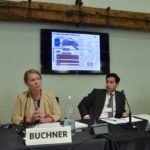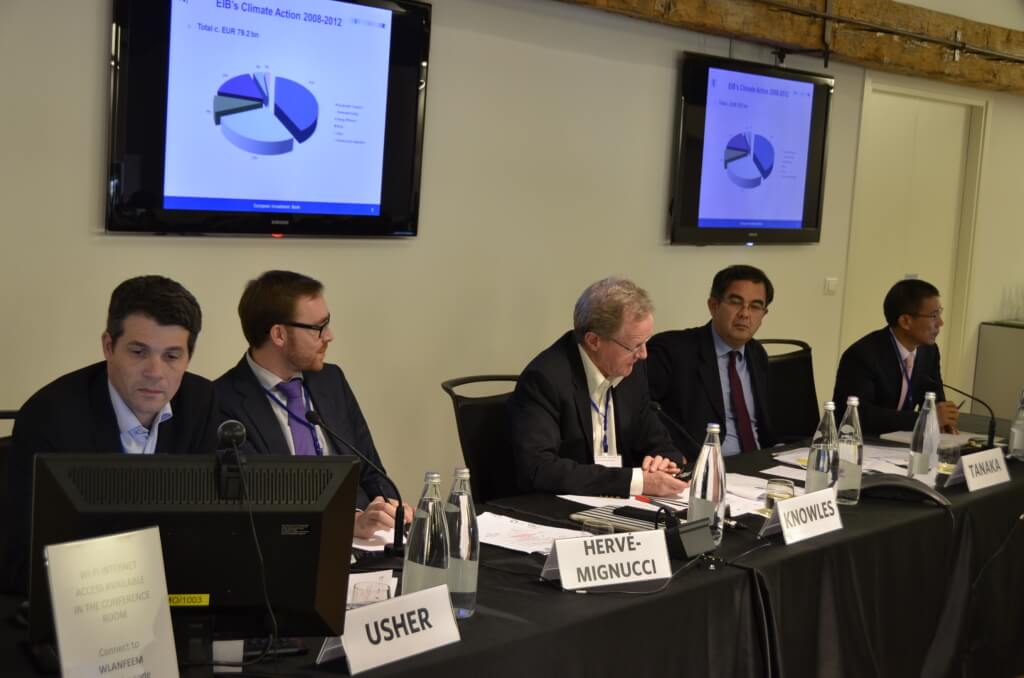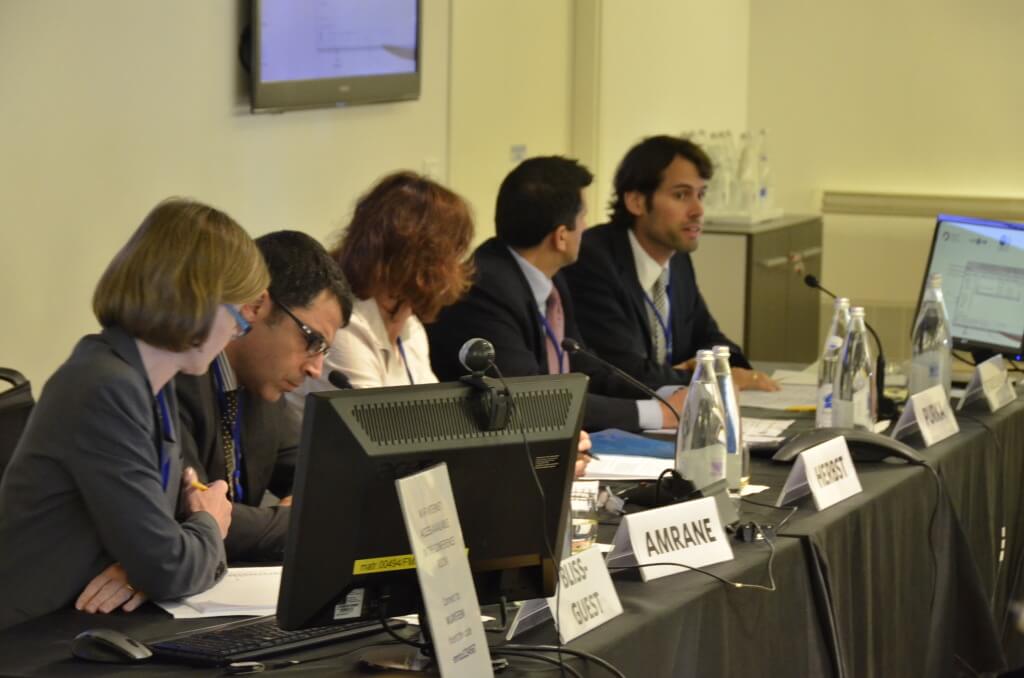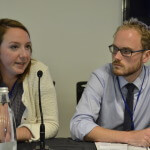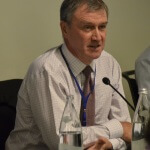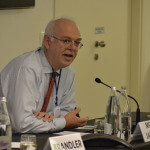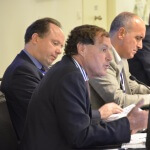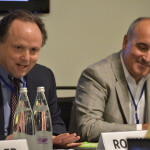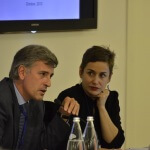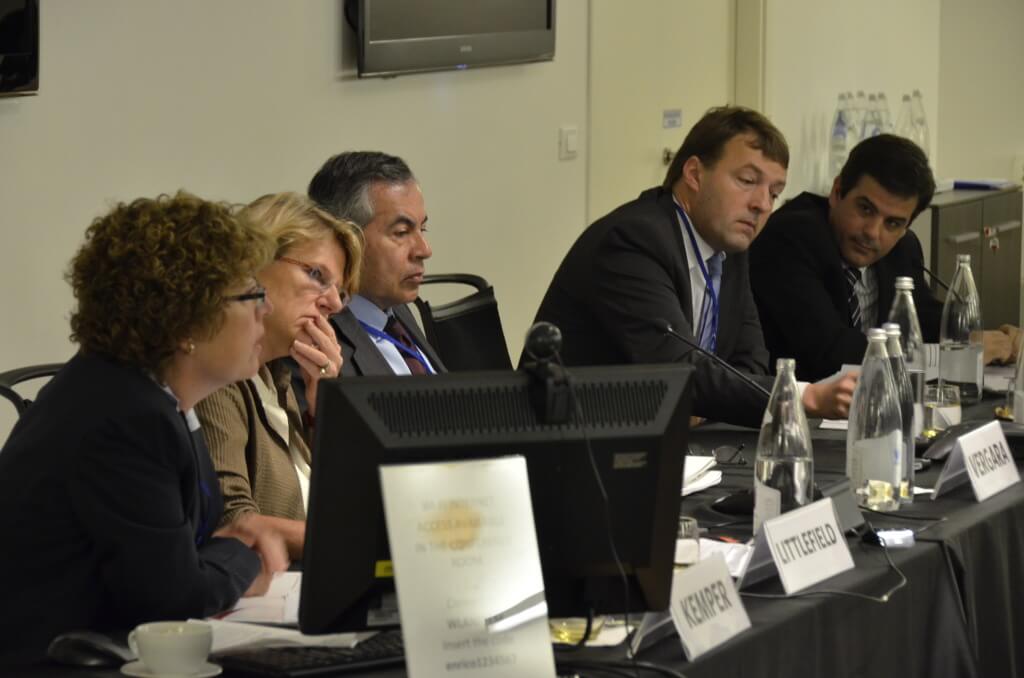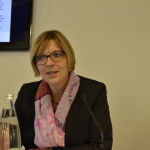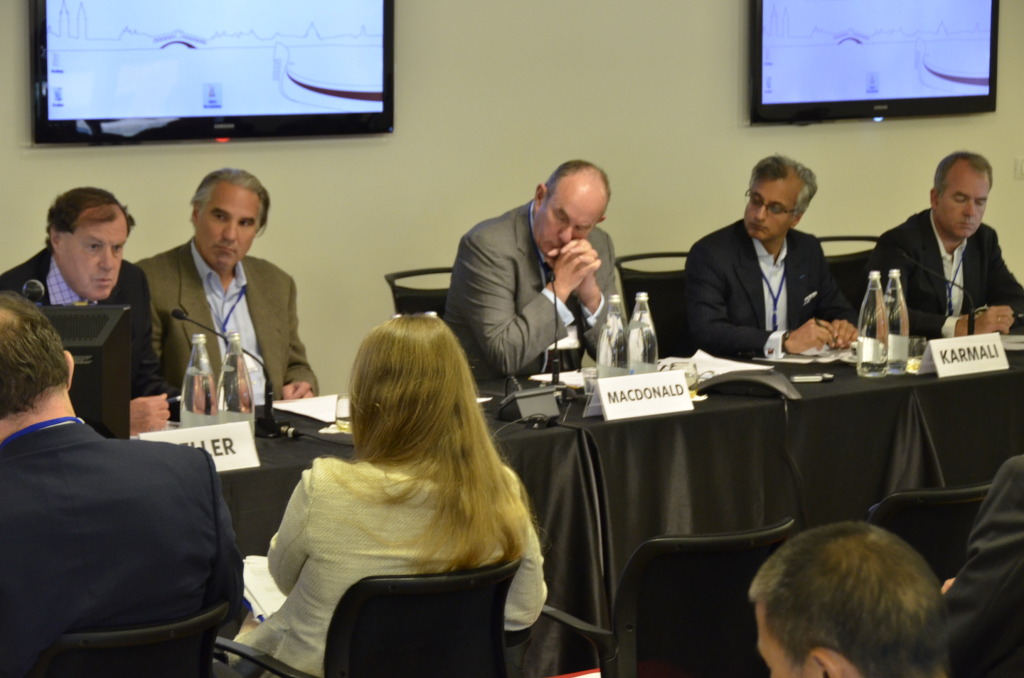Organized by Climate Policy Initiative (CPI) in collaboration with the World Bank Group, China Light Power (CLP) and the Organisation for Economic Co-operation and Development (OECD), the Third Annual Meeting of the San Giorgio Group was held over one and a half days on the Island of San Giorgio Maggiore in Venice. The San Giorgio Group assembles key financial intermediaries and institutions actively engaged in green, low-emissions finance.
This year’s meeting began with an overview of the current landscape of climate finance, identifying different pathways, processes, and portfolio decisions in play. Throughout a series of sessions, the Group was able to explore lessons learned from detailed case studies. Focus sessions looked at significant portfolios and projects in energy efficiency, concentrated solar power, onshore wind, and climate resilience. Drawing from experiences across the spectrum of green finance, workshop sessions explored instruments for addressing risks related to green investments and the role of Development Finance Institutions in facilitating green investments. The final Concluding Session took stock of lessons learned, highlighting key issues that require attention in order to render green, low-emissions finance effective, and asking what the San Giorgio Group should do next?
For further information on the San Giorgio Group, please contact info@cpivenice.org.

Agenda and Presentations
Thursday, 03 October 2013
Welcome
Thomas Heller, Executive Director, Climate Policy Initiative
Introductory Panel: Green, Low-Emissions Finance – The Global State of Play
This session considered current public and private sector financing of climate-related activities, setting the scene for its participants to introduce focal themes and questions to guide our discussions. We looked at developments over the past year affecting the current climate finance landscape, including new information about the emerging importance of different actors and instruments, among them green bonds. Panelists presented views on the role of public and private finance in scaling up green, low-emissions finance, and explored how these flows compare to investments in traditional, fossil fuel activities.
Chair: Stacy Swann, World Bank Task Force to Catalyze Climate Action, The World Bank
Panelists:
- Barbara Buchner, Senior Director, Climate Policy Initiative Europe
Presentation: The Landscape of Climate Finance 2013
- Ben Caldecott, Head of Government Advisory, Bloomberg New Energy Finance
Presentation: Green, Low Emissions Finance – State of Play
- Helen Mountford, Deputy Director of the Environment Directorate, Organisation for Economic Co-operation and Development
Presentation: Green Vs. Brown: Shifting the Finance Flows
- Sean Kidney, Chief Executive Officer, Climate Bonds Initiative
Presentation: Bonds and Climate Change: The State of the Market in 2013
-
S. Swann, B. Buchner, B. Caldecott
Focus 1: Financing Market Transformation: The Case of Energy Efficiency?
Energy efficiency projects face particular difficulties in attracting private capital. This session explored whether public support for energy efficiency has contributed to market transformation and learning. Panelists shared experiences on how effective specific instruments and policies have been in transforming energy efficiency and local financial intermediaries markets across countries and identified potential for learning and replication. Panelists presented views on emerging best practices and explored which frameworks need to be in place to scale up investments in energy efficiency.
Chair: Eric Usher, Acting Head, Energy Finance Unit, United Nations Environment Programme
Panelists:
- Morgan Hervé-Mignucci, Managing Analyst, Climate Policy Initiative
- Christopher Knowles, Associate Director, European Investment Bank
Presentation: Financing Market Transformation: The Case of Energy Efficiency? EIB Experiences
- Josué Tanaka, Managing Director, Operational Strategy and Planning, Energy Efficiency and Climate Change, European Bank for Reconstruction and Development
- Ming Yang, Senior Climate Change Specialist, the Global Environment Facility
Presentation: Energy Efficiency Finance in the US and China
Focus 2: Financing High-Cost Renewable Energy: The Case of CSP
Concentrated Solar Power (CSP) is a promising technology for low-carbon growth, as it not only generates carbon-free electricity, but its storage capabilities also suit base-load requirements. However, the high cost of this technology impedes its deployment at speeds or scales sufficient to meet demand. CSP electricity costs are among the highest in renewable energy, and public interventions are needed to make CSP projects financially viable and drive down technology costs. Existing CSP projects may offer insights on viable ways to achieve economies of scale, reduce costs, and close the competitiveness gaps. This session asked what policies have and have not worked in facilitating high-cost investments in CSP technologies to make them a viable option for countries looking to meet growing demand. Panelists shared experiences from existing CSP projects to examine the effectiveness of public interventions for financing CSP and explore what is needed to scale up projects like these, both in terms of project design factors and political support.
Chair: Patricia Bliss-Guest, Program Manager, Climate Investment Funds
Panelists:
- Obaid Amrane, Board Member, Moroccan Agency for Solar Energy
Presentation: The Moroccan Solar Plan
- Penny Herbst, Corporate Specialist Renewables, Eskom
Presentation: Expanding Green, Low-Emissions Finance: Financing High-Cost Renewable Energy – The Case of CSP
- Don Purka, Principal Investment Specialist, Asian Development Bank
Presentation: Early Lessons Learned from CSP in India
- Martin Stadelmann, Senior Analyst, Climate Policy Initiative
Focus 3: Financing the Diffusion of Commercial Renewable Energy: The Case of Onshore Wind
Onshore wind is a commercial renewable energy technology. Despite strong market penetration of wind technology, the question is how to further accelerate investment, to facilitate a major shift in the global energy infrastructure. To understand the risks and returns related to onshore wind projects, we considered the case of Jädraås Onshore Windfarm, the largest onshore windfarm in Scandinavia when commissioned in early 2013: Despite a poor lending environment, Jädraås managed to attract EUR 360 million in private investment. The session discussed the role of well-articulated state-backed policies and financial instruments in facilitating investment and how these mobilize non-traditional investors. Panelists explored the role of export guarantees and institutional investors in scaling up investments in onshore windfarms and other nonconventional technologies.
Chair: Marjolein van Noort, Manager Public Affairs, IHC Merwede
Presenter: Rodney Boyd, Analyst, Climate Policy Initiative
Presentation: Jädraås Onshore Windfarm
Commentators:
- Andrew Brandler, Chief Executive Officer, CLP Holdings Limited
- Lars Molte Jakobsen, Deputy Director, EKF (Eksport Kredit Fonden) Denmark
Presentation: Funding at EKF
-
M. van Noort, R. Boyd
-
A. Brandler
-
L.M. Jakobsen
Focus 4: Financing Climate Resilience
The private sector plays prominent roles in key economic sectors vulnerable to climate change. While private actors are likely to face negative climate change impacts, affecting employment and the overall economic development of the country, they also offer expertise, products and services that can smooth the path to adaptation. However, several barriers to tapping into private sector potential for financing adaptation exist. Within the Pilot Program for Climate Resilience (PPCR), the funding window of the Climate Investment Funds supporting highly vulnerable countries to adapt to climate variability and change, we considered the project “promoting climate-resilient agriculture” in Nepal, implemented by the International Finance Corporation. Panelists explored different ways of engaging the private sector in adaptation, related challenges, and shared experiences on replicable and scalable practices.
Chair: Kruskaia Sierra-Escalante, Acting Head, Blended Finance for Climate, Climate Business Department, International Finance Corporation, The World Bank Group
Panelists:
- Chiara Trabacchi, Analyst, Climate Policy Initiative
Presentation: Pilot Program for Climate Resilience: Making Adaptation a Private Sector Business – Evidence from Nepal’s Agricultural Sector
- Jan Corfee-Morlot, Team Leader for Environment, Climate Change and Development, OECD Development Co-operation Directorate
Presentation: Private Sector Engagement: Recent Insights from OECD Work
- Pieter Pauw, Researcher, German Development Institute
Stocktaking Session
This session focused on what combination of policies and financial instruments is needed to achieve system transformation, pulling together early lessons on how to finance technologies both close to and far from commercial viability. It also explored the implications that continuing investment in traditional, fossil fuel power generation might have on financing low-carbon, climate-resilient technologies, and new risks that investors in ‘traditional’ energy generation may face. Panelists also shared insights from Italy’s experience of achieving system transformation based on PV. Brief opening remarks by panelists were followed by an open discussion with the audience.
Panelists:
- Thomas Heller, Executive Director, Climate Policy Initiative
- Nick Robins, Head of Climate Change Centre, HSBC Bank
Presentation: High and Low-Carbon System Transformation: Landing and Stranding
- Sandro De Poli, President and CEO, General Electric, Italy and Israel
Presentation: Ecoimagination
- Ugo Govigli, Vice President, Energy Solutions NEC EMEA; President, NEC Italia
Presentation: The Experience of Renewables in Italy
Moderated by: Jane Wilkinson, Director, Climate Policy Initiative
-
T. Heller, N. Robins, S. De Poli
-
N. Robins, S. De Poli
-
U. Govigli, J. Wilkinson
Social Dinner
Dinner remarks on The Global Commission on the Economy and Climate
- Tom Heller, Executive Director, and Barbara Buchner, Senior Director, Climate Policy Initiative
Friday, 04 October 2013
Panel: The Role of Development Finance Institutions in Facilitating Green Investments
Development Finance Institutions and Development Banks (DFIs and DBs) are deeply knowledgeable about specific sectors and the local economic and long-term investment environment in which investments are structured and made. Their long-standing relationships with the local private sector and their access to a range of financial instruments give them a special advantage to tap into and pool private capital. This session shared experiences on how the Brazilian Development Bank (BNDES), Inter-American Development Bank, KfW Development Bank and Overseas Private Investment Cooperation, work to ‘green’ their portfolios and internal practices. Panelists presented views on how to leverage the role of DFIs and DBs to help scale up green, low-emissions investment.
Chair: Karin Kemper, Director, Climate Policy and Finance Department,
The World Bank
Panelists:
- Elizabeth Littlefield, President and CEO, Overseas Private Investment Cooperation
- Jochen Harnisch, Head of Division, Competence Center Environment and Climate/ Coordinator Climate Change Policy, KfW Development Bank
Presentation: The Role of Development Finance Institutions in Facilitating Green Investments
- Antonio Tovar, Head of Alternative Energy Sources Department, Brazilian Development Bank (BNDES)
Presentation: BNDES Brazilian Development Bank
- Walter Vergara, Chief, Climate Change and Sustainability Division, Inter-American Development Bank
Presentation: Financing Low Carbon, Climate Resilient Development
Panel: Instruments for Addressing Risks Related to Green Investments
Whether real or perceived, risk is the single most important factor keeping promising projects from finding investors. There are gaps between project developers’ and financial investors’ demand for risk coverage and the risk coverage instruments that both private and public entities currently supply. This session addressed specific existing and innovative risk coverage instruments. Panelists discussed the latest developments in policy risk insurance mechanisms and first loss guarantee instruments, and considered whether further improvements are needed to bridge the gap between supply and demand for risk coverage in order to unlock capital for green investments at scale.
Chair: Silvia Kreibiehl, Head of Centre, Frankfurt School UNEP Collaborating Centre for Climate and Sustainable Energy Finance
Presentation: Renewable Energy Performance Platform
Panelists:
- Gianleo Frisari, Analyst, Climate Policy Initiative
- Antonio Barbalho, Global Head, Energy and Extractive Industries, Multilateral Investment Guarantee Agency, The World Bank Group
Presentation: Multilateral Investment Guarantee Agency: Enhancing Investments in Climate Friendly Projects
- Michael Schneider, Director, Head of Environmental and Social Capital, Deutsche Bank
- Vikram Widge, Head, Climate Finance and Policy, Climate Business Department, International Finance Corporation, The World Bank Group
Presentation: Institutional Investor Engagement
-
S. Kreibiehl
Concluding Panel: Priorities Ahead
The concluding panel brought together experts from the policy and finance communities to explore a strategy and highlight priorities going forward to scale up green, low-emissions investment. Based on the preceding sessions and the San Giorgio Group’s emphasis on learning lessons from evolving practices, panelists highlighted key issues that require attention to render green, low-emissions finance effective in order to:
- identify the working agenda and main questions for the San Giorgio Group
in 2014;
- explore the role of various actors and institutions in strengthening contributions to green, low-emissions finance;
- discuss implications of the San Giorgio Group work for the design of the Green Climate Fund.
Chair: Thomas Heller, Executive Director, Climate Policy Initiative
Panelists:
- Matthew Arnold, Managing Director, Head of the Office of Environmental Affairs, JP Morgan Chase and Co.
- Donald MacDonald, Chairman, Institutional Investors Group on Climate Change
- Abyd Karmali, Managing Director and Global Head of Carbon Markets, Bank of America Merrill Lynch
Presentation: Scaling Up Climate Finance: Priorities Ahead
- Tomas Anker Christiansen, Ambassador, Senior Advisor for Partnerships at United Nations
Closing of the meeting by Thomas Heller, Executive Director, Climate Policy Initiative.

Presentation: The Landscape of Climate Finance 2013
Presentation: Green, Low Emissions Finance – State of Play
Presentation: Green Vs. Brown: Shifting the Finance Flows
Presentation: Bonds and Climate Change: The State of the Market in 2013
- S. Swann, B. Buchner, B. Caldecott
Presentation: Financing Market Transformation: The Case of Energy Efficiency? EIB Experiences
Presentation: Energy Efficiency Finance in the US and China
Presentation: The Moroccan Solar Plan
Presentation: Expanding Green, Low-Emissions Finance: Financing High-Cost Renewable Energy – The Case of CSP
Presentation: Early Lessons Learned from CSP in India
Presentation: Jädraås Onshore Windfarm
Presentation: Funding at EKF
- M. van Noort, R. Boyd
- A. Brandler
- L.M. Jakobsen
Presentation: Pilot Program for Climate Resilience: Making Adaptation a Private Sector Business – Evidence from Nepal’s Agricultural Sector
Presentation: Private Sector Engagement: Recent Insights from OECD Work
Presentation: High and Low-Carbon System Transformation: Landing and Stranding
Presentation: Ecoimagination
Presentation: The Experience of Renewables in Italy
- T. Heller, N. Robins, S. De Poli
- N. Robins, S. De Poli
- U. Govigli, J. Wilkinson
The World Bank
Presentation: The Role of Development Finance Institutions in Facilitating Green Investments
Presentation: BNDES Brazilian Development Bank
Presentation: Financing Low Carbon, Climate Resilient Development
Presentation: Renewable Energy Performance Platform
Presentation: Multilateral Investment Guarantee Agency: Enhancing Investments in Climate Friendly Projects
Presentation: Institutional Investor Engagement
- S. Kreibiehl
in 2014;
Presentation: Scaling Up Climate Finance: Priorities Ahead

